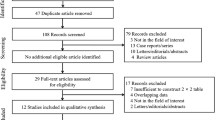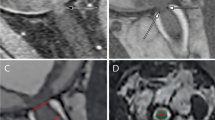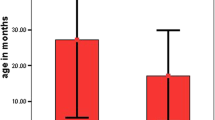Abstract
Objectives
To determine the diagnostic accuracy of conventional MRI in detecting tumour invasion of advanced intraocular retinoblastoma and to correlate ADC values with high-risk prognostic parameters.
Method
The sensitivities, specificities, positive predictive values (PPV), negative predictive values (NPV) and accuracies of MRI in detecting tumour-extent parameters of 63 retinoblastomas were determined. Furthermore, ADC values were correlated with high-risk prognostic parameters.
Results
MRI detected postlaminar optic nerve with a sensitivity of 73.3% (95% CI 44.9–92.2%) and a specificity of 89.6% (77.3–96.5%), while the specificity for choroidal invasion was only 31.8% (13.9-54.9%). Likewise, MRI failed to predicted early optic nerve invasion in terms of low sensitivity and PPV. In contrast, scleral and ciliary body invasion could be correctly excluded with high NPV. ADC values were significantly lower in patients with undifferentiated tumours, large tumour size, as with optic nerve and scleral invasion (all p < 0.05). However, no correlation was found between ADC values and the degree of choroidal or ciliary body infiltration. Additionally, ADC values were negatively correlated with Ki-67 index (r = −0.62, P = 0.002).
Conclusions
Conventional MRI has some limitations in reliably predicting microscopic infiltration, with the diagnostic efficiency showing room for improvement, whereas ADC values correlated well with certain high-risk prognostic parameters for retinoblastoma.
Key points
• Conventional MRI failed to predicted microscopic infiltration of the retinoblastoma.
• Scleral and ciliary body invasion could be excluded with high NPV.
• ADC values correlated well with some high-risk pathological prognostic parameters.





Similar content being viewed by others
Abbreviations
- ADC:
-
apparent diffusion coefficient
- DWI:
-
diffusion-weighted imaging
- MRI:
-
magnetic resonance imaging
- NEX:
-
number of excitations
- ROI:
-
region of interest
References
Moll AC, Kuik DJ, Bouter LM et al (1997) Incidence and survival of retinoblastoma in the Netherlands: a register based study 1862-1995. Br J Ophthalmol 81:559–562
Zhao J, Li S, Shi J, Wang N (2011) Clinical presentation and group classification of newly diagnosed intraocular retinoblastoma in China. Br J Ophthalmol 95:1372–1375
Shields CL, Shields JA (2006) Basic understanding of current classification and management of retinoblastoma. Curr Opin Ophthalmol 17:228–234
Gao YJ, Qian J, Yue H et al (2011) Clinical characteristics and treatment outcome of children with intraocular retinoblastoma: a report from a Chinese cooperative group. Pediatr Blood Cancer 57:1113–1116
Canturk S, Qaddoumi I, Khetan V et al (2010) Survival of retinoblastoma in less-developed countries impact of socioeconomic and health-related indicators. Br J Ophthalmol 94:1432–1436
Linn Murphree A (2005) Intraocular retinoblastoma: the case for a new group classification. Ophthalmol Clin North Am 18:41–53
Atchaneeyasakul LO, Wongsiwaroj C, Uiprasertkul M (2009) Prognostic factors and treatment outcomes of retinoblastoma in pediatric patients: a single-institution study. Jpn J Ophthalmol 53:35–39
Kopelman JE, McLean IW, Rosenberg SH (1987) Multivariate analysis of risk factors for metastasis in retinoblastoma treated by enucleation. Ophthalmology 94:371–377
Yannuzzi NA, Francis JH, Marr BP et al (2015) Enucleation vs ophthalmic artery chemosurgery for advanced intraocular retinoblastoma: a retrospective analysis. JAMA Ophthalmol 133:1062–1066
Bellaton E, Bertozzi AI, Behar C et al (2003) Neoadjuvant chemotherapy for extensive unilateral retinoblastoma. Br J Ophthalmol 87:327–329
Chantada GL, Gonzalez A, Fandino A et al (2009) Some clinical findings at presentation can predict high-risk pathology features in unilateral retinoblastoma. J Pediatr Hematol Oncol 31:325–329
Wilson MW, Qaddoumi I, Billups C (2011) A clinicopathological correlation of 67 eyes primarily enucleated for advanced intraocular retinoblastoma. Br J Ophthalmol 95:553–558
de Jong MC, van der Meer FJ, Goricke SL et al (2016) Diagnostic accuracy of intraocular tumor size measured with MR imaging in the prediction of postlaminar optic nerve invasion and massive choroidal invasion of retinoblastoma. Radiology 279:817–826
Khurana A, Eisenhut CA, Wan W et al (2013) Comparison of the diagnostic value of MR imaging and ophthalmoscopy for the staging of retinoblastoma. Eur Radiol 23:1271–1280
de Graaf P, Barkhof F, Moll AC et al (2005) Retinoblastoma: MR imaging parameters in detection of tumor extent. Radiology 235:197–207
Friedman DN, Lis E, Sklar CA et al (2014) Whole-body magnetic resonance imaging (WB-MRI) as surveillance for subsequent malignancies in survivors of hereditary retinoblastoma: a pilot study. Pediatr Blood Cancer 61:1440–1444
de Graaf P, van der Valk P, Moll AC et al (2010) Contrast-enhancement of the anterior eye segment in patients with retinoblastoma: correlation between clinical, MR imaging, and histopathologic findings. AJNR Am J Neuroradiol 31:237–245
Galluzzi P, Cerase A, Hadjistilianou T et al (2003) Retinoblastoma: abnormal gadolinium enhancement of anterior segment of eyes at MR imaging with clinical and histopathologic correlation. Radiology 228:683–690
Hilario A, Sepulveda JM, Perez-Nunez A et al (2014) A prognostic model based on preoperative MRI predicts overall survival in patients with diffuse gliomas. AJNR Am J Neuroradiol 35:1096–1102
Abdel Razek AA, Kamal E (2013) Nasopharyngeal carcinoma: correlation of apparent diffusion coefficient value with prognostic parameters. Radiol Med 118:534–539
Razek AA, Gaballa G, Denewer A et al (2010) Invasive ductal carcinoma: correlation of apparent diffusion coefficient value with pathological prognostic factors. NMR Biomed 23:619–623
Bossuyt PM, Reitsma JB, Bruns DE et al (2015) STARD 2015: an updated list of essential items for reporting diagnostic accuracy studies. Radiology 277:826–832
Eagle RC Jr (2009) High-risk features and tumor differentiation in retinoblastoma: a retrospective histopathologic study. Arch Pathol Lab Med 133:1203–1209
Wilson MW, Rodriguez-Galindo C, Billups C et al (2009) Lack of correlation between the histologic and magnetic resonance imaging results of optic nerve involvement in eyes primarily enucleated for retinoblastoma. Ophthalmology 116:1558–1563
Sastre X, Chantada GL, Doz F et al (2009) Proceedings of the consensus meetings from the International Retinoblastoma Staging Working Group on the pathology guidelines for the examination of enucleated eyes and evaluation of prognostic risk factors in retinoblastoma. Arch Pathol Lab Med 133:1199–1202
Balaguer J, Wilson MW, Billups CA et al (2009) Predictive factors of invasion in eyes with retinoblastoma enucleated after eye salvage treatments. Pediatr Blood Cancer 52:351–356
Kaliki S, Shields CL, Rojanaporn D et al (2013) High-risk retinoblastoma based on international classification of retinoblastoma: analysis of 519 enucleated eyes. Ophthalmology 120:997–1003
Sirin S, Schlamann M, Metz KA et al (2015) High-resolution MRI using orbit surface coils for the evaluation of metastatic risk factors in 143 children with retinoblastoma: Part 1: MRI vs. histopathology. Neuroradiology 57:805–814
Schueler AO, Hosten N, Bechrakis NE et al (2003) High resolution magnetic resonance imaging of retinoblastoma. Br J Ophthalmol 87:330–335
Lemke AJ, Kazi I, Mergner U et al (2007) Retinoblastoma - MR appearance using a surface coil in comparison with histopathological results. Eur Radiol 17:49–60
de Jong MC, de Graaf P, Noij DP et al (2014) Diagnostic performance of magnetic resonance imaging and computed tomography for advanced retinoblastoma: a systematic review and meta-analysis. Ophthalmology 121:1109–1118
Chawla B, Sharma S, Sen S et al (2012) Correlation between clinical features, magnetic resonance imaging, and histopathologic findings in retinoblastoma: a prospective study. Ophthalmology 119:850–856
Song KD, Eo H, Kim JH et al (2012) Can preoperative MR imaging predict optic nerve invasion of retinoblastoma? Eur J Radiol 81:4041–4045
Brisse HJ, Guesmi M, Aerts I et al (2007) Relevance of CT and MRI in retinoblastoma for the diagnosis of postlaminar invasion with normal-size optic nerve: a retrospective study of 150 patients with histological comparison. Pediatr Radiol 37:649–656
Lee BJ, Kim JH, Kim DH et al (2012) The validity of routine brain MRI in detecting post-laminar optic nerve involvement in retinoblastoma. Br J Ophthalmol 96:1237–1241
de Graaf P, Goricke S, Rodjan F et al (2012) Guidelines for imaging retinoblastoma: imaging principles and MRI standardization. Pediatr Radiol 42:2–14
Brisse HJ, de Graaf P, Galluzzi P et al (2015) Assessment of early-stage optic nerve invasion in retinoblastoma using high-resolution 1.5 Tesla MRI with surface coils: a multicentre, prospective accuracy study with histopathological correlation. Eur Radiol 25:1443–1452
Abdel Razek AA, Elkhamary S, Al-Mesfer S et al (2012) Correlation of apparent diffusion coefficient at 3T with prognostic parameters of retinoblastoma. AJNR Am J Neuroradiol 33:944–948
de Graaf P, Pouwels PJ, Rodjan F et al (2012) Single-shot turbo spin-echo diffusion-weighted imaging for retinoblastoma: initial experience. AJNR Am J Neuroradiol 33:110–118
Author information
Authors and Affiliations
Corresponding author
Ethics declarations
Guarantor
The scientific guarantor of this publication is Dengbin Wang.
Conflict of interest
The authors of this manuscript declare no relationships with any companies whose products or services may be related to the subject matter of the article.
Funding
This work was supported by the fund of National Nature Science Foundation of China (NSFC No.81371621), the Programs of Shanghai Municipal Health Outstanding Discipline Leader (No. XBR 2013110) and Shanghai Shenkang Hospital Development Center (No. SHDC 22015022).
Statistics and biometry
No complex statistical methods were necessary for this paper.
Informed consent
Written informed consent was waived by the institutional review board.
Ethical approval
Institutional review board approval was obtained.
Methodology
• retrospective
• diagnostic or prognostic study
• performed at one institution
Rights and permissions
About this article
Cite this article
Cui, Y., Luo, R., Wang, R. et al. Correlation between conventional MR imaging combined with diffusion-weighted imaging and histopathologic findings in eyes primarily enucleated for advanced retinoblastoma: a retrospective study. Eur Radiol 28, 620–629 (2018). https://doi.org/10.1007/s00330-017-4993-7
Received:
Revised:
Accepted:
Published:
Issue Date:
DOI: https://doi.org/10.1007/s00330-017-4993-7




